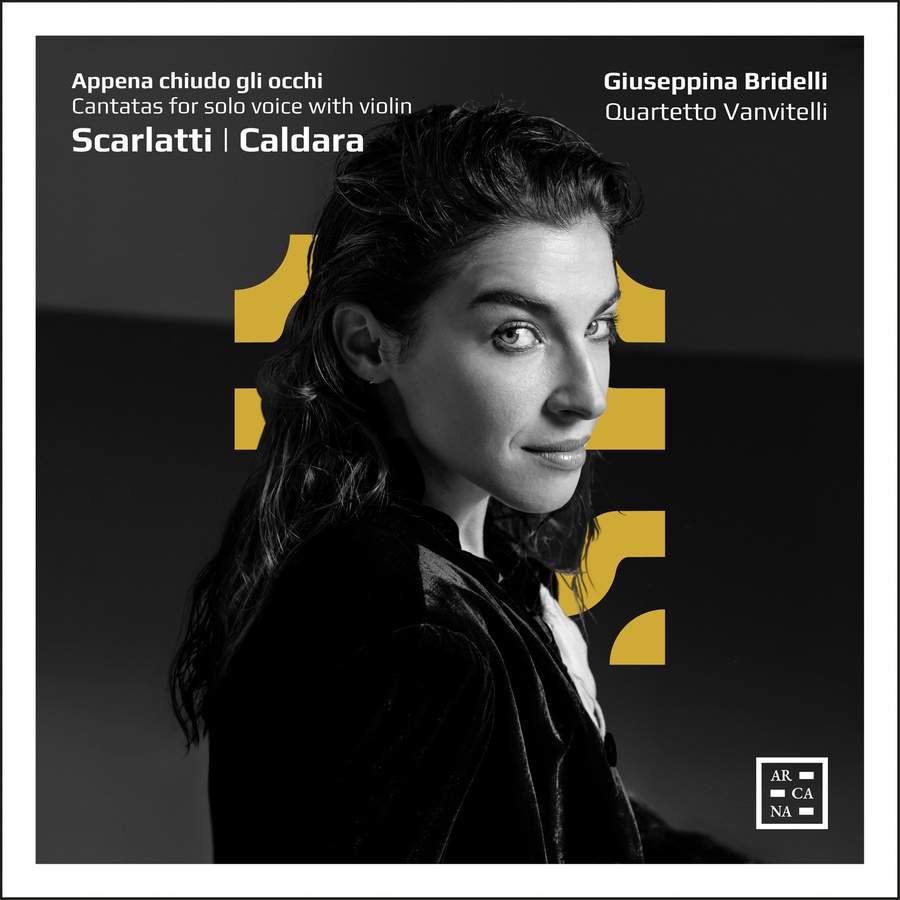Appena Chiudo Gli Occhi: Cantatas for Solo Voice with Violin ( Giuseppina Bridelli)
View record and artist detailsRecord and Artist Details
Genre:
Vocal
Label: Arcana
Magazine Review Date: 09/2021
Media Format: CD or Download
Media Runtime: 77
Mastering:
DDD
Catalogue Number: A487

Tracks:
| Composition | Artist Credit |
|---|---|
| Dove fuggo? A che penso? |
(Pietro) Alessandro (Gaspare) Scarlatti, Composer
Giuseppina Bridelli, Soprano Quartetto Vanvitelli |
| Vicino a un rivoletto |
Antonio Caldara, Composer
Giuseppina Bridelli, Soprano Quartetto Vanvitelli |
| (12) Sonatas for Violin and Continuo, 'Alletamenti, Movement: No 1 D minor |
Giuseppe Valentini, Composer
Giuseppina Bridelli, Soprano Quartetto Vanvitelli |
| Innocente cor mio |
Antonio Caldara, Composer
Giuseppina Bridelli, Soprano Quartetto Vanvitelli |
| Appena chiudo gli occhi |
(Pietro) Alessandro (Gaspare) Scarlatti, Composer
Giuseppina Bridelli, Soprano Quartetto Vanvitelli |
Author: David Vickers
The Sicilian Alessandro Scarlatti and the Venetian Antonio Caldara probably crossed paths several times in Rome, for example during Lent 1708, when each of them produced new oratorios sponsored by Cardinal Ottoboni and Marquis Ruspoli at their respective palaces (the series culminated in Handel’s La Resurrezione). Other than their scoring for solo voice, one violin and basso continuo, the four chamber cantatas presented here have no obvious connections, although Scarlatti’s Appena chiudo gli occhi is preserved in a collection of manuscripts that originally belonged to Ruspoli – who was Caldara’s employer from 1709 to 1716 (although the Venetian’s two cantatas featured here were both composed after he settled in a prestigious job for life in Vienna). As an interlude, there is a vivacious five-movement violin sonata by Giuseppe Valentini, one of Ruspoli’s household musicians, published in Rome in 1714.
Giuseppina Bridelli and Quartetto Vanvitelli exploit kaleidoscopic articulations, shapes and textures as each emotional state demands. Scarlatti’s imaginative depiction of Clori’s dejection at Fileno’s cruelty oscillates between pathetic laments and outpourings of seething frustration in Dove fuggo? A che penso?. Caldara’s Vicino a un rivoletto presents the lovelorn king of Mauritania invoking a warbling bird in ‘Zeffiretto amorosetto’ (an opportunity for Gian Andrea Guerra’s violin to soar and chirrup sweetly in dialogue with Bridelli’s rapturous singing), and expressing desire in ‘Ahimé, sento il mio core’ (the instrumental spotlight given to Nicola Brovelli’s melancholic cello, although Bridelli’s gentle vocal intimacy is obscured by Luigi Accardo’s sustained organ continuo). The poetry of Caldara’s Innocente cor mio is somewhat oblique but there is no ambiguity in Bridelli’s extrovert warning that inflammable love can burn you. Scarlatti’s Appena chiudo gli occhi is introduced by a two-movement sinfonia played with compassion and refinement. Its text describes a woman (presumably Clori) unable to sleep at night for dreaming about the far-away and unattainable Fileno with equal elation and misery; Scarlatti’s masterly contrapuntal writing is to the forefront in the lament ‘Dolce sonno, d’ogni mal quiete e riposo’, and the insomniac’s complaint concludes with frenzied bitterness (‘Amico sonno, deh, per pietate’). A fascinating and vivid exploration of little-known Italian Baroque masterpieces.
Discover the world's largest classical music catalogue with Presto Music.

Gramophone Digital Club
- Digital Edition
- Digital Archive
- Reviews Database
- Full website access
From £8.75 / month
Subscribe
Gramophone Full Club
- Print Edition
- Digital Edition
- Digital Archive
- Reviews Database
- Full website access
From £11.00 / month
Subscribe
If you are a library, university or other organisation that would be interested in an institutional subscription to Gramophone please click here for further information.




